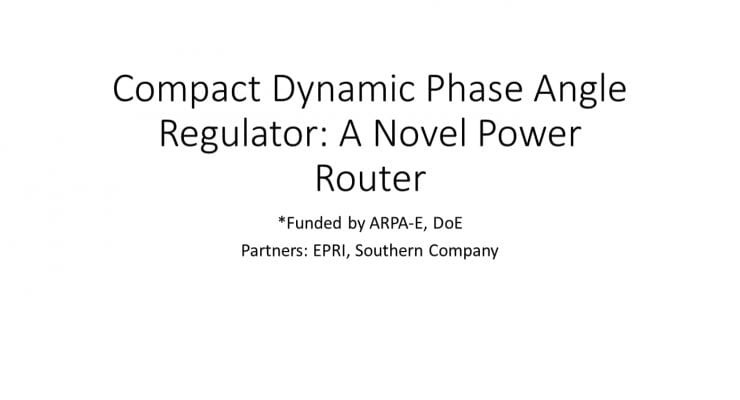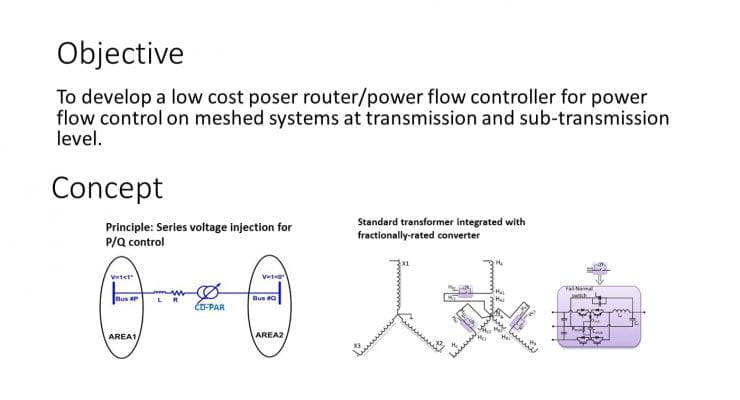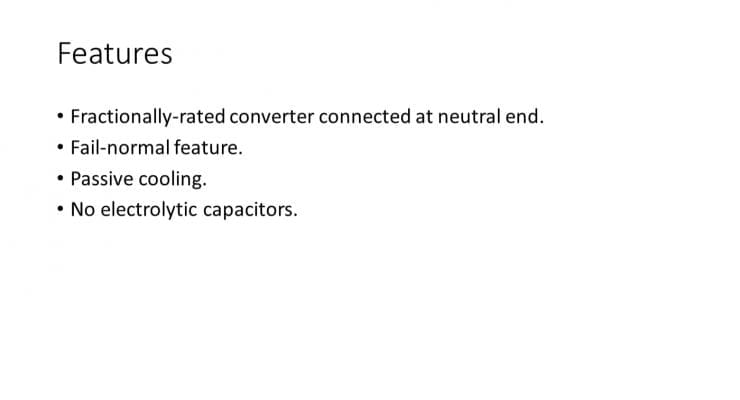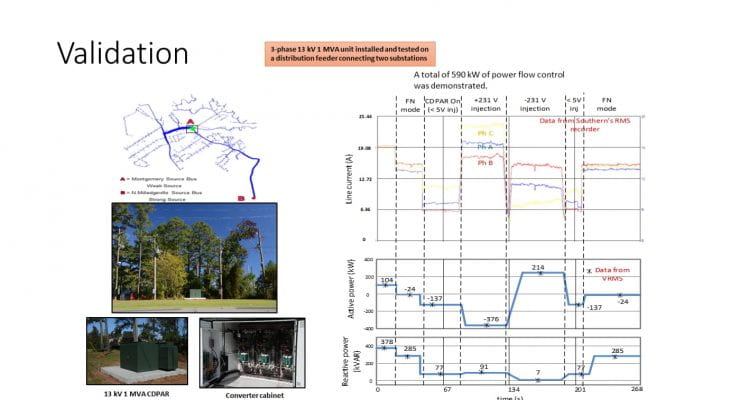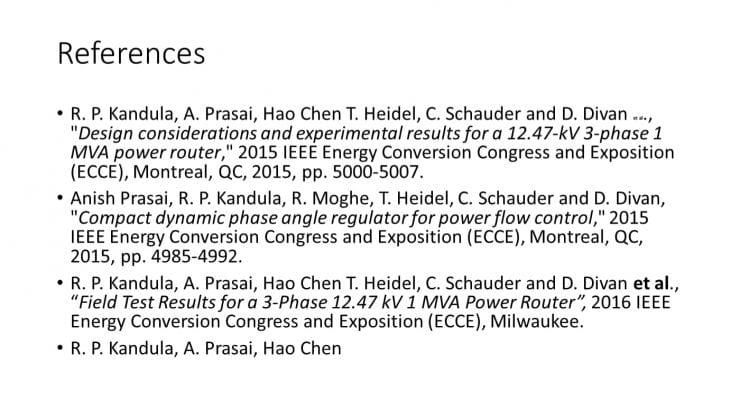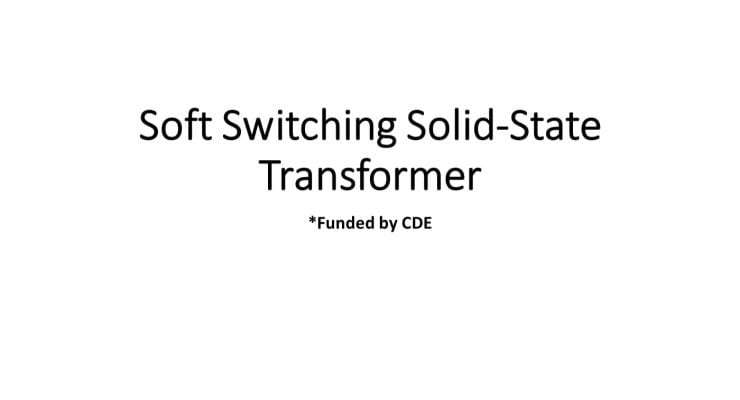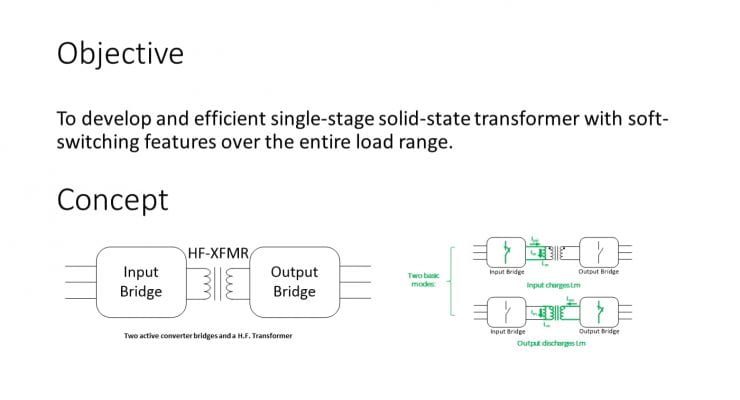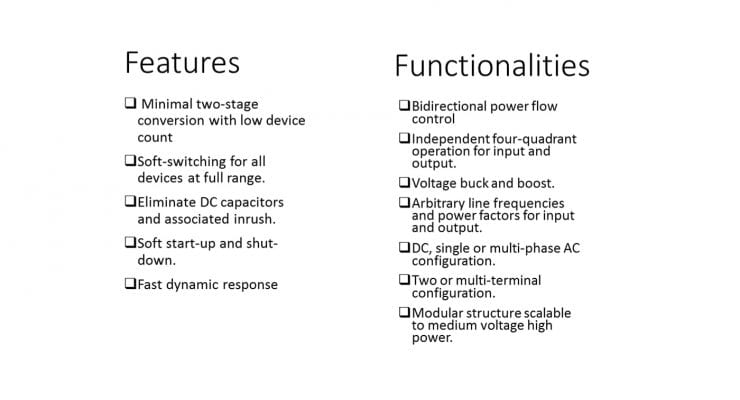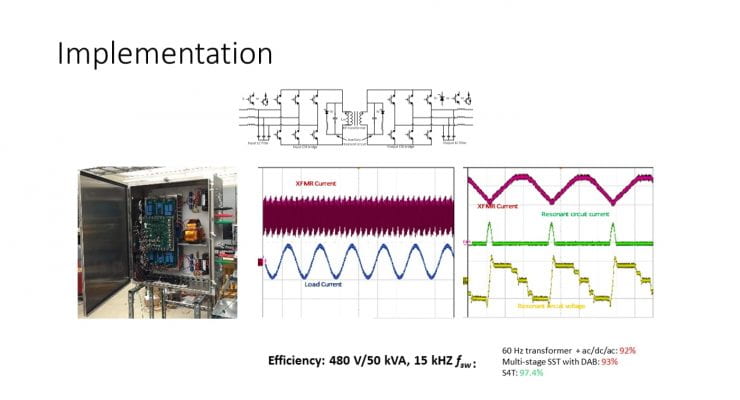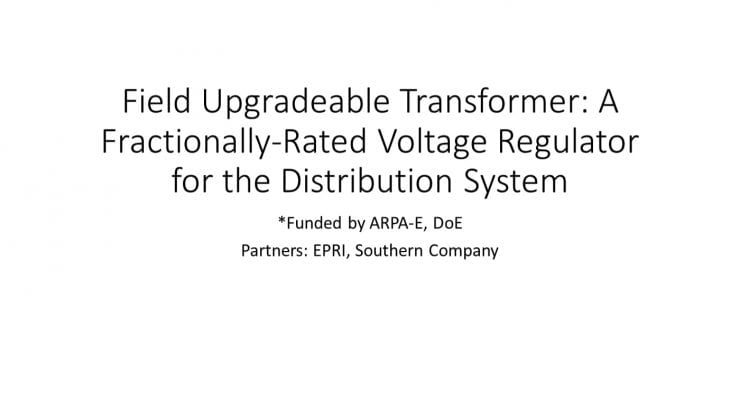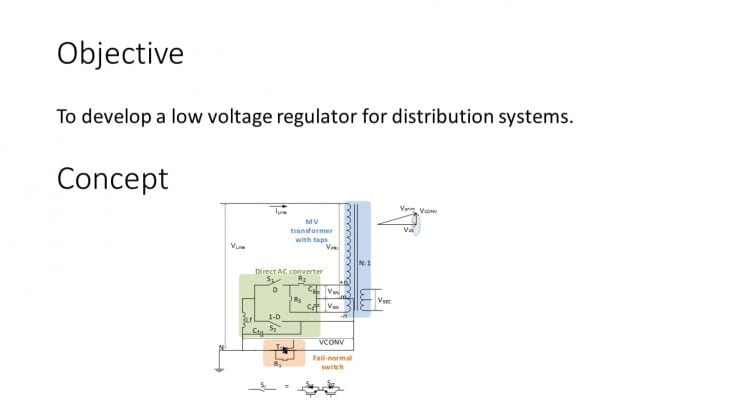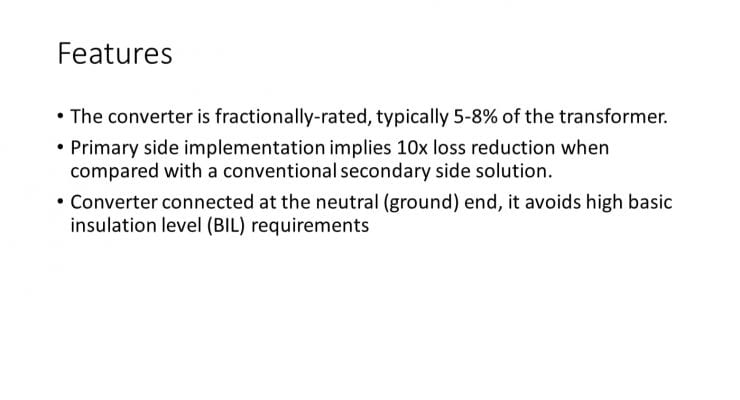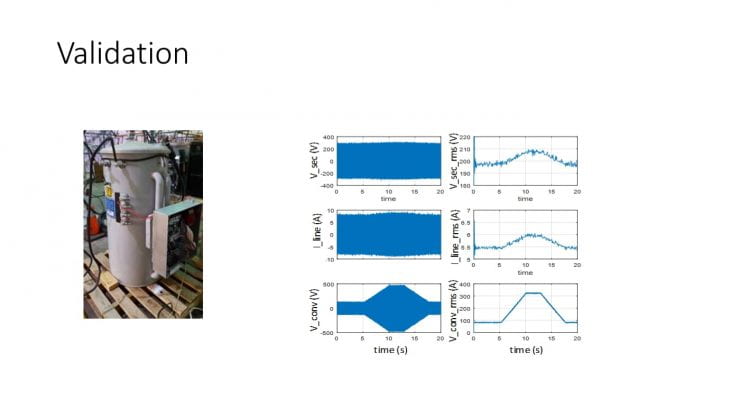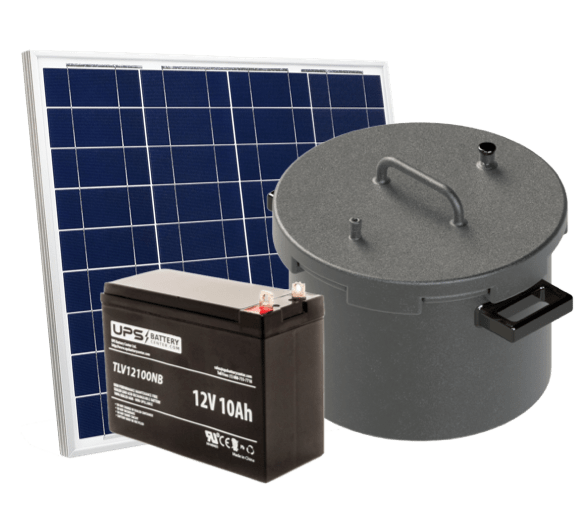Compact Dynamic Phase Angle Regulator
Soft Switching Solid-State Transformer
Upgradeable Transformer
2020 Featured Projects
[expand title=”Grid Asset Augmentation” trigclass=”impact-dropdown” rel=”group1″ elwrapclass=”blueblaster” tag=”h2″]
Demonstration of 24 kV 5 MVA Modular Controllable Transformer
Personnel: Mickael Mauger, Rohit Jinsiwale, Prasad Kandula, Frank Lambert, Dr. Divan
Sponsor: Department of Energy (Partners – Delta-Star, Clemson University, ORNL, Southern Company)
Large Power Transformers (LPTs) are critical pieces of grid infrastructure. Failure of these units can cause a significant loss of load across the system. The objective of this project is to develop Modular Controllable Transformers (MCTs), consisting of the association of a standard power transformer and a fractionally-rated power electronic converter, that can increase grid resilience while achieving standardization across the system. Added features like power flow control, impedance control, voltage support and volt-var control make this application all the more attractive. A 50 MVA 139kV/46kV unit with +/- 8% voltage injection has been designed in Phase 1 of this project. Phase 2 will design, build and test a 5 MVA 24 kV/12 kV MCT unit to prove the concept experimentally and demonstrate the functionality.
Grounded Controllable Network Transformer (G-CNT)
Personnel: Mickael Mauger, Prasad Kandula, Deepak Divan, Brandon Royal
Sponsor: ARPA-E (Partners – EPRI, Southern Company, Delta-Star)
The objective is to develop a grounded controllable network transformer (G-CNT) to offer a cost-effective approach to implementing and scaling dynamic control for the grid, with impact on diverse factors including grid resilience, DER integration, reducing loop flows, improving performance under contingencies, and reducing congestion. The team has designed, built and tested a 12.47 kV /1 MVA unit to demonstrate the core technology. Over 850 kVA of active and reactive decoupled P and Q control has been demonstrated experimentally at 12.47 kV with a power converter rated at only 40 kVA. The fail-normal functionality has also been demonstrated at rated voltage and power flows.
Grounded Compact Dynamic Phase Angle Regulator (G-CDPAR)
Personnel: Mickael Mauger, Prasad Kandula, Deepak Divan
Sponsor: ARPA-E (Partners – Varentec, Southern Company, EPRI)
Design, build and test a 13 kV/1 MVA grounded compact dynamic phase angle regulator (G-CDPAR) for power flow control. In this project, 3-phase 1 MVA CDPAR unit was designed, built and tested on a 13 kV feeder, demonstrating 600 kVA (+/- 2⁰) dynamic power flow control. In addition, three 13 kV 1 MVA G-CDPAR units have been inserted in a 3-phase 13 kV 5-bus 6-line test bed and demonstrated stable operation of multiple CDPAR units.
Field Upgradable Transformer (FUT)
Personnel: Prasad Kandula, Karthik Kandasamy, Deepak Divan
Sponsor: Southern Company
Increased load demand and penetration levels of renewable energies are imposing great challenges in maintaining the voltage profile of the distribution feeders at high quality. In this project a device, called flexible transformer which can provide +/- 8% Volt-VAR control at 7.2 kV 50 kVA will be developed. The device consists of a fractionally-rated converter and a slightly modified medium voltage (MV) distribution transformer with additional taps. The proposed device successfully meets the requirements of great performance, long lifetime, high efficiency, and low cost for typical utility assets.
Stacked Isolated Voltage Optimization Modules in LV Meshed Grid Systems
Personnel: Rohit Jinsiwale, Sathish Jayaraman, Prasad Kandula, Frank Lambert, Brandon Royal, Dr. Divan
Sponsor: Consolidated Edison/NEETRAC
Meshed grids are designed to be robust architectures where the lowest probability of outage can be achieved. Load variations and line impedances dictate the flow of power through this grid creating issues like transformer overloads and poor voltage profile. Stacked Isolated Voltage Optimization Modules (SIVOM) based on Coaxial winding geometries are proposed as a solution towards transformer loading reduction and voltage support while adding a degree of controllability to the system.
[/expand]
[expand title=”Next Generation Grid Power Electronics” trigclass=”impact-dropdown” rel=”group2″ elwrapclass=”blueblaster” tag=”h2″]
HF Isolated Triport Converter for PV Plus Storage System
Personnel: Zheng An, Xiangyu Han, Karthik Kandasamy, Prasad Kandula, Dr. Divan, Frank Lambert, Brandon Royal
Sponsor: Prolec GE/NEETRAC
Design, build and test a modular soft-switching solid-state transformer (M-S4T) based triport converter at 80 kVA / 690 V DC / 2.4 kV single-phase AC with four modules. The isolated triport converter can integrate the PV and storage to grid and eliminate one additional converter for storage port. The M-S4T will be tested for power flow at 80 kVA, +/- 12.5% reactive power support and fault current sourcing capability (5 p.u. for 30 cycles). The major challenge is voltage sharing across series connected modules under steady-state and transient states.
 Modular HF Isolated MV String Inverters Enable a New Paradigm for Large PV Farms
Modular HF Isolated MV String Inverters Enable a New Paradigm for Large PV Farms
Personnel: Zheng An, Xiangyu Han, Karthik Kandasamy, Prasad Kandula, Dr. Divan, Brandon Royal
Sponsor: Department of Energy (Partners – First Solar, Southern Company, ORNL, EPRI, Paul Centolella)
Develop and demonstrate a single-stage modular isolated soft-switching MV string inverters (MVSI) with tri-ports configuration to interconnect PV and storage to MV grid. The modular MVSI provides advanced functionalities such as energy storage units integration without additional converters, independent control of PV, storage and grid power, lower distribution losses in the PV farm by connection to MV grid, high-frequency galvanic isolation, high modularity and scalability. The prototype will be tested at 300 MVA / 1000 Vdc (PV) / 650 Vdc (battery). The successful demonstration of this project will bring down the Balance of System (BOS) cost and show >8% reduction in the levelized cost of energy (LCOE) compared to the state-of-art approaches.
 Characterization of Reverse Blocking SiC Devices Under ZVS Conditions
Characterization of Reverse Blocking SiC Devices Under ZVS Conditions
Personnel: Xiangyu Han, Liran Zheng, Prasad Kandula, Karthik Kandasamy, Dr. Divan, Dr. Saeedifard
Sponsor: Power America
Silicon Carbide (SiC) MOSFETs with higher voltage ranges are becoming the device of choice for medium-voltage power electronics systems. Currently, 3.3 kV power modules have reached their commercial release with their detailed hard-switching characterization and performance evaluation. This project presents device characterization results for 3.3 kV Reverse-Blocking (RB) SiC devices, the basic building blocks for current source (CS) converters, under Zero Voltage Switching (ZVS) conditions. The results from hard switching and soft switching conditions are compared to highlight the effectiveness and necessity of soft switching when using 3.3 kV RB devices. The impact of parasitic inductances and capacitances on switching performance of 3.3 kV SiC devices is analyzed.


Implementation of Modular Soft-Switching Solid-State Transformer (M-S4T) on OPAL-RT Platform
Personnel: Xiangyu Han, Liran Zheng, Prasad Kandula, Karthik Kandasamy, Dr. Saeedifard, Dr. Divan
Sponsor: Power America
Modeling of low-inertia soft-switching converters, such as soft-switching solid-state transformers (S4T), particularly for implementing fast-dynamic control using hardware-in-the-loop (HIL) tools is challenging. The control becomes complex when such low-inertia converters need to be stacked using modular S4T modules (M-S4T) for medium voltage applications. The non-idealities of the controller, sensors and communication channels etc. should be considered in modelling for HIL simulation to verify such fast-dynamic control algorithm. A quasi-real-time (QRT) HIL model is proposed to simulate this type of converters and controls. By using the proposed model on HIL platform, the simulation speed can be 100 times faster compared to the single-core simulator.
 5 kV DC to LV DC or 3 Phase AC Converter with HF Link (S4T)
5 kV DC to LV DC or 3 Phase AC Converter with HF Link (S4T)
Personnel: Liran Zheng, Xiangyu Han, Prasad Kandula, Karthik Kandasamy, Brandon Royal , Maryam Saeedifard, Dr. Divan
Sponsor: Power America/DOE
Availability of wide-bandgap power devices, in particular, Silicon Carbide (SiC) devices and power modules rated at >3.3 kV and 50-200 Amperes can completely change the distribution paradigm, enabling efficient, compact and cost-effective DC distribution systems that can provide higher reliability, resiliency and functionality than is possible today. In this project the team has designed, built, and tested a 50 kVA MVDC – 3 phase LVAC (or LVDC) isolated bidirectional power converter module that can serve as a building block for higher-voltage higher-power systems. The modules feature integrated high frequency isolation, low EMI through low dv/dt, and high efficiency over the full operating load range realized with soft switching techniques. All the features have been experimentally verified at 4 kV 20 kVA.
 Grid-Connected Modular Soft-Switching Solid State Transformers (M-S4T)
Grid-Connected Modular Soft-Switching Solid State Transformers (M-S4T)
Personnel: Liran Zheng, Xiangyu Han, Chunmeng Xu, Jia Wei, Xiwei Zheng, Prasad Kandula, Karthik Kandasamy, Brandon Royal , Frank Lambert, Prof. Rhett Mayor, Prof. Maryam Saeedifard, Prof. Lukas Graber, Prof. Deepak Divan
Sponsor: ARPA-E/DoE (Partners – Southern Company, EPRI)
Georgia Tech Research Corporation and its project team will develop a solid-state transformer for medium-voltage grid applications using silicon carbide with a focus on compact size and high-performance. Traditional grid connected transformers have been used for over 100 years to ‘step down’ higher voltage to lower voltage. Higher voltages allow for delivery of power over longer distances and lower voltages keeps consumers safe. But traditional distribution transformers lack integrated sensing, communications, and controls. They also lack the ability to control the voltage, current, frequency, power factor or anything else to improve local or global performance. Solid-state transformers can provide improvements and Georgia Tech’s design seeks to address major roadblocks to their implementation, namely insulation, cooling, voltage change, and magnetic field issues, as well as downstream protection against abnormal current faults. If successful, the team will greatly increase transformer functionality while reducing its size over current technologies, affecting application areas like grid energy storage, solar photovoltaics and electric vehicle fast chargers, while also enabling better grid monitoring and easy retrofits.
 Meeting BIL management for grid connected power electronics
Meeting BIL management for grid connected power electronics
Personnel: Liran Zheng, Xiangyu Han, Chunmeng Xu, Jia Wei, Xiwei Zheng, Prasad Kandula, Karthik Kandasamy, Brandon Royal , Frank Lambert, Prof. Rhett Mayor, Prof. Maryam Saeedifard, Prof. Lukas Graber, Prof. Deepak Divan
Sponsor: ARPA-E/DoE (Partners – Southern Company, EPRI)
One of the major challenges for grid connected power electronics is to effectively manage Basic impulse level (BIL), the requirement driven by the capability to withstand lightning surges. For a 13 kV system, the BIL requirement is typically 90-110 kV. Typical approach is to interface the power electronics (PE) to the grid through a 60 Hz transformer, essentially defeating the purpose of solid state transformers. The objective of this project is to develop a BIL management stage which can be used as an interface element between the PE and the grid that can effectively absorb the lightning surges. Accordingly, a BIL management stage based on multi-stage hybrid surge arrester is designed, built and tested successfully at 90 kV BIL. [/expand]
[/expand]
[expand title=”Next Generation Industrial Power Electronics” trigclass=”impact-dropdown” rel=”group3″ elwrapclass=”blueblaster” tag=”h2″]
Soft-switching Current Source Integrated Drive Train for Electric Vehicle
Personnel: Mickael Mauger, Prasad Kandula, Deepak Divan
Sponsor: ARPA-E (Sub-award under $3M project with Professor Yogendra Joshi, METTL, Georgia Tech)
The objective is to design a 120 kVA SiC-based soft-switching current source integrated drive-train for electric vehicle. The soft-switching current source inverter (SSCSI) topology provides controlled dv/dt, eliminates the need for complex EMI filters, enables the use of SiC devices, improves power density compared to traditional drive solutions and achieves high conversion efficiencies across the entire load range. In addition, the current-sourced converter features benign failure mode (no short-circuit current) and simplifies the parallel connection of multiple units for a scalable modular design with increased reliability and ‘limp-home’ feature on converter failure. The 120 kVA drive-train will consist of two 60 kVA modules, connected in parallel, and use advanced power electronics packaging and thermal management strategies, developed in collaboration with the Microelectronics & Emerging Technologies Thermal Laboratory (METTL) and Packaging Research Center (PRC) at Georgia Tech.
 Soft-Switching Solid State Transformer (S4T) Universal Module
Soft-Switching Solid State Transformer (S4T) Universal Module
Personnel: Mickael Mauger, Prasad Kandula, Dr. Divan, Brandon Royal
Sponsor: CDE/GRA
The objective of this project is to address the manufacturability and build the first prototypes of a universal S4T module to be used as a standard building block across all target low-voltage applications. The modules can interface with any DC, single or multi-phase AC system up to 480 Vac or 750 Vdc. The modules can be paralleled to meet the power level of the application and offer (N-X) redundancy capabilities for uninterrupted operation. The target metric for the module include a rated power of >25kVA, a BOM cost <$2500, a 19-inch rack format with two-men ‘replace & repair` capability, and a life expectancy of over 25 years. A first 25 kVA prototype module has been successfully tested at rated current and voltage levels and a re-design for increased power density, to 50 kVA in the same packaging, is currently ongoing.
 Energy Hub for Fast Charging Applications
Energy Hub for Fast Charging Applications
Personnel: Mickael Mauger, Prasad Kandula, Deepak Divan, Brandon Royal
Sponsor: Southern Company
The objective of this project it to build a 50 kVA 240V Energy Hub for fast charging applications. Energy Hub is based on a Soft Switching Solid State Transformer (S4T) that provides multiple functions such as connecting to the grid, delivering solar power, battery energy storage and VARs for grid support; Functioning as a microgrid for critical infrastructure during power outages or on utility dispatch; Providing DC as a service, including for DC fast charging, data centers and large PV farms; Reducing and managing the peak demand of connected load and DC fast charging on the grid. Energy Hub can be transported to affected areas to provide grid services and improve resiliency. In this project a 50 kW energy hub will be built and tested in the field.
 Characterization and Loss Analysis of High Frequency Transformers under DC Bias Conditions
Characterization and Loss Analysis of High Frequency Transformers under DC Bias Conditions
Personnel: Xiwei Zheng, Mickael Mauger, Prasad Kandula, Deepak Divan, Brandon Royal
Sponsor: CDE
High-frequency transformers are a critical component of any solid state transformer. In the Soft-Switching Solid-State Transformer (S4T), the high-frequency transformer is operating under DC bias conditions, and only one winding is active during the active energy transfer time. This objective of this project is to characterize and analyze the AC copper loss and core loss in the high-frequency transformer resulting from these atypical operating conditions. Preliminary analytical calculation along with FEM analysis and experimental testing show that overall transformer losses are under 0.4 % for a 25kVA 480V/480V S4T.
 Industrial Applications of SIVOM
Industrial Applications of SIVOM
Personnel: Sathish Jayaraman, Rohit Jinsiwale, Prasad Kandula, Dr. Divan, Brandon Royal
Sponsor: CDE
A solution to realize fast control of the ac line voltage at low-voltage (120-600 volts) and high current (100 to 6,000 Amperes) – which can, when applied in manufacturing plants and commercial buildings, lead to reduction in power demand and energy consumption without any loss in productivity, and can also reduce unscheduled downtime caused by power disturbances.
 Managing Mechanical Forces in SIVOM Devices Under Fault Current Conditions
Managing Mechanical Forces in SIVOM Devices Under Fault Current Conditions
Personnel: Sathish Jayaraman, Rohit Jinsiwale
Sponsor: CDE
Stacked Isolated Voltage Optimization Modules (SIVOM) based on coaxial winding transformer (CWT) in utility and industrial applications can experience high levels of fault current (>50 kA). Traditional magnetic elements, such as transformers, can experience very high forces that can damage the components. Coaxial winding structures can offer lower levels of mechanical force. This project is aimed at understanding, modeling, measuring and designing CWTs to manage 50 kA of fault currents in easy to build designs.
[expand title=”Global Asset Monitoring Management & Analytics (GAMMA) Platform” trigclass=”impact-dropdown” rel=”group4″ elwrapclass=”blueblaster” tag=”h2″]
Global Asset Monitoring Management and Analytics Platform (GAMMA)
Personnel: Shreyas Kulkarni, Qinchen Gu, Szilard Liptak, Lalith Polepeddi, Pooja Khurana, Stephen Piper, Raheem Beyah, Deepak Divan
Sponsor: Center for Distributed Energy
GAMMA is a low-cost secure long-life ‘device to cloud’ platform to manage millions of globally deployed assets. Energy devices such as sensors, actuators, smart meters and energy access devices can be connected to the cloud using an ultra-low-cost GAMMA Bridge, which can offer zero cost of communications through the use of a ‘delay tolerant network’. GAMMA also includes administrative and data management functions, as well as analytics needed to support the needs of a wide group of stakeholders using mobile and web based GAMMA user interfaces. GAMMA is designed to reduce the cost and complexity of deploying and managing large fleets of inexpensive assets.
 Gamma Distribution Automation AMI Node
Gamma Distribution Automation AMI Node
Personnel: Shreyas Kulkarni, Qinchen Gu, Szilard Liptak, Lalith Polepeddi, Raheem Beyah, Deepak Divan
Sponsor: Center for Distributed Energy
Design and build low-cost (<$20), GAMMA-compliant ‘Distribution Automation nodes’, capable of revenue grade metering, ‘Pay-As-You-Go’ billing, remote disconnect, volt/VAR support and power quality monitoring. Intelligence embedded on the node can report theft detection, outages, voltage sags, swells, frequency deviations and factor in bi-directional power flows. Device can also accommodate dynamic pricing and intelligence to actuate/manage home loads. A customer-facing mobile application is developed to visualize power consumption profiles and manage individual accounts (add balance etc), while a utility front-end is used to visualize trends across the system.
 Sensing Electrical Networks Securely & Economically (SENSE)
Sensing Electrical Networks Securely & Economically (SENSE)
Personnel: Shreyas Kulkarni, Qinchen Gu, Kavya Ashok, Dan Li, Szilard Liptak, Lalith Polepeddi, Nagi Gebraeel, Raheem Beyah, Deepak Divan
Sponsor: U.S. Department of Energy (Partners – ORNL, Southern Company)
Project aims at development and demonstration of secure, ubiquitous low-cost sensor networks for monitoring service transformers. Novel sensing techniques for measuring current, voltage and temperature will be developed, and sensors manufactured using techniques compatible with volume production. Sensor design will integrate flexible energy management, communications, data storage and cybersecurity. Using built-in intelligence, the sensor can extract actionable information that needs to be reported to the cloud, and work with intermittent connectivity (GAMMA compliant). Cloud based analytics can help in managing a fleet of utility assets and optimization across the network. The project will culminate in a field demonstration of sensors on two distribution feeders with the utility partner and a service-based business model to enhance returns on investment.
 Clip-on Current Sensor with Wide Dynamic Range
Clip-on Current Sensor with Wide Dynamic Range
Personnel: Shreyas Kulkarni and Deepak Divan, Brandon Royal
Sponsor: U.S. Department of Energy & Center for Distributed Energy
Rogowski coil current sensors are popular solutions, having several advantages over current transformers (CTs), including size, bandwidth and dynamic range. These sensors have been used by electric utilities for gaining visibility into the electric grid directly helping in grid operations. This project developed a PCB-based Rogowski coil that can be retrofitted around any existing conductor, resulting in a sensor that can be rapidly installed in the field. Due to the absence of any magnetic components in the coil, Rogowski coils cannot saturate and thus have a very high dynamic range, only limited by the accompanying signal conditioning or data converter circuits. In order to prevent saturation of the signal conditioning stage at higher current levels, a method to auto-tune the sensor has developed, resulting in a dynamic range that is orders of magnitude higher than state of the art. The method, called dynamic range correction (DRC), uses edge intelligence to detect fault current scenarios and adjust the analog circuit to prevent saturation or distortion, while capturing the fault current waveforms. This feature enables post-event diagnostics for electric utilities at a very low cost.
 Gamma IoT High Current Terminal Block
Gamma IoT High Current Terminal Block
Personnel: Aniruddh Marellapudi, Shreyas Kulkarni, Szilard Liptak, Deepak Divan, Brandon Royal
Sponsor: Center for Distributed Energy
The GAMMA Intelligent Terminal Block is a low-cost (<$50), GAMMA-compliant industrial sub-meter designed to address the issues of high installation effort, high system cost (> $400/node), and limited data analysis existing in present industrial sub-meters. Our meter is designed to operate within a wide range of voltage and current (up to 480V L-L and up to 400A) in single-phase, split-phase, and three-phase configurations. Data from a fleet of these sensors is aggregated in the GAMMA cloud, a business-facing web application used to visualize and analyze industrial power flows. In addition to standard power flow analysis, the GAMMA cloud’s advanced analytics features include load consumption profiles across all major loads in a plant, CVR factor estimation for potential energy savings, power quality monitoring to determine its impact on plant productivity and efficiency, load disaggregation, and electrical fault diagnostics with fault-triggered auto-scaling and waveform capture. Overall, this sub-metering solution can unlock actionable insights for higher productivity and efficiency in industrial settings.
Personnel: Stephen Piper, Qinchen Gu, Szilard Liptak, Lalith Polepeddi, Deepak Divan, Brandon Royal
Sponsor: Center for Distributed Energy
Healing Waters International is a non-profit organization serving the poor globally through safe water solutions in more than 360 locations in 16 countries on 3 continents. Monitoring their water purification systems is a major challenge due to remote location of these systems and poor connectivity options. The Gamma distributed communication system is well suited to bridge this communication gap and provide a simple, low-cost way of monitoring these set of devices.
Personnel: Szilard Liptak, Stephen Piper, Pooja Khurana, Qinchen Gu, Shreyas Kulkarni, Lalith Polepeddi, Deepak Divan, Brandon Royal
Sponsor: IEEE Empower a Billion Lives, Center for Distributed Energy
IEEE Empower a Billion Lives is a global competition to crowdsource innovation to develop solutions to energy poverty. After 3 years, and two rounds, the competition is in its final phase, where 23 teams from 4 continents compete for the Global Prizes. The Finalists are completing field trials to showcase their solutions and the competition organizers needed a way to monitor these systems in poor connectivity areas in 23 different locations in 15 countries easily without excessive communications expenses. Gamma provided a suitable solution to this problem using a Bluetooth-based delay-tolerant monitoring system, that seamlessly logs an arbitrary set of measurements locally, relays it to the cloud when cellphones pass by, and visualize it the gathered data on a web app and phone app for ease of access.
[expand title=”Advanced AMI, Sensors & Analytics” trigclass=”impact-dropdown” rel=”group5″ elwrapclass=”blueblaster” tag=”h2″]
Grid Edge Voltage Volatility
Personnel: Kavya Ashok, Yamille de Ville, Frank Lambert, Dr. Divan
Sponsor: NEETRAC
Unexpectedly high voltage volatility is being observed at the grid edge, both in AMI data as well as grid edge sensors. Utility models cannot currently explain the level of voltage volatility, which significantly limits the Volt/VAR control range, and much of the smart grid benefits targeted by US utilities. There is a mismatch between the expected voltage profile using feeder models and the actual voltages measured at end customers that needs to be studied.
Personnel: Kavya Ashok, Matthew J. Reno, Frank Lambert, Dr. Divan
Sponsor: CDE/Sandia National Labs
Utilities are deploying AMI systems, with the expectation that the data gathered would provide rich insight into their systems and would help to manage them better. This project is looking at combined distribution feeder data, including AMI data, substation data and utility feeder models. Keeping in mind the physical nature of the grid and connected loads, one is able to extract important information such as connectivity, impedances, remote voltages, theft detection, and prognostics on distribution network operation. The algorithms developed are being validated using detailed simulation as well as with real feeder data.
[expand title=”Decentralized Grid Control Techniques and Markets” trigclass=”impact-dropdown” rel=”group6″ elwrapclass=”blueblaster” tag=”h2″]
Dynamic Self-Pricing Grids Using Market Nodes
Personnel: Rohit Jinsiwale, Dr. Divan
Sponsor: Center for Distributed Energy
With exponentially decreasing prices of PV the adoption of volatile and non-dispatchable sources into the grid has increased. Reliance on high speed communication and complex computations to handle these fast phenomena introduces points of failure and dramatically decreases the controllability and resiliency of the system. Real-time pricing mechanisms ensure that demand and source flexibility can be leveraged to hedge this volatility by balancing demand with available generation. The approach presented here allows a grid price to be related to system frequency. This reduces the dependence on communication and elaborate computation while allowing every connected agent access to real-time prices. The approach remains agnostic to system topologies and configurations making it fractal while allowing multiple prosumers to collectively stabilize the system while meeting global objectives. The system can leverage maximum elasticity so as to sustain operation in a resource deficit or surplus scenario.
 Collaborative Volt-VAR Control Using Grid-Connected PV Inverters
Collaborative Volt-VAR Control Using Grid-Connected PV Inverters
Personnel: Mohammadreza Miranbeigi, Prasad Kandula, Deepak Divan, Brandon Royal
Sponsor: Center for Distributed Energy
This project proposes a new Volt-VAR control strategy for grid-connected PV inverters. The new standard has mandated contribution of PV inverters to improve voltage volatility by employing a linear droop curve with a dead-band. This strategy limits the range of controllability of inverters and does not necessarily guarantee oscillation-free response of them outside of the band. Our new proposed method employs a nonlinear adaptive curve that works solely based on local information and improves the range of Volt-VAR control of inverters. The results show that by using this strategy, the system has a less oscillatory response compared to the conventional linear droop methods.
 Microgrid-to-Grid Interface Issues
Microgrid-to-Grid Interface Issues
Personnel: Nishant Bilakanti, Prasad Kandula, Dr. Divan, Frank Lambert
Sponsor: NEETRAC
To identify the key issues with high DER/microgrid penetration and to propose mitigation strategies. The project also looks at developing a standard microgrid-to-grid interface (Island Interconnection Device) to simplify the integration of microgrids with the grid while meeting the ever-evolving interconnection standards and not requiring an interconnection study, retrofits or firmware upgrades of microgrid components. In addition to enforcing the rules for interconnection set by the utility to ensure the integrity of the grid regardless of the topology, configuration, and control of the microgrid (assets), the IID can also provide ancillary services and grid-support.
 Designing a Simulation Platform to Analyze the Interaction of Multiple Autonomous Converters with the Grid and Each Other
Designing a Simulation Platform to Analyze the Interaction of Multiple Autonomous Converters with the Grid and Each Other
Personnel: Sanaz Paran, Prasad Kandula, Dr. Divan
Sponsor: Center for Distributed Energy
The project proposes a platform for designing a large distribution network with the penetration of PV and converters. The converters are being designed to be autonomous, making control decisions based on local parameters. The behavior of these autonomous and self-learning controllers needs to be analyzed to ensure stable operation of the grid under steady state and all possible transient. For this purpose, we utilized the Opal-RT which provides a complete range of real-time simulation and control prototyping systems for power grids and power electronics for a wide variety of applications including large power grids and renewable energy systems.
[expand title=”Energy Access for Emerging Markets” trigclass=”impact-dropdown” rel=”group7″ elwrapclass=”blueblaster” tag=”h2″]
SONG: Self Organizing Nano Grid
Personnel: Szilard Liptak, Mohammadreza Miranbeigi, Shreyas Kulkarni, Deepak Divan
Sponsor: CDE
A “plug and play” interface for energy devices which is flexible in terms of sources & loads. SONG is a smart system that is capable of interfacing with wide range of renewable sources and energy storage elements. Implement optimization strategies for Battery Management systems. Scalability: Capable of interfacing a string of such devices to increase the overall power rating of the system. Modular architecture of SONG system allows system to grow as the individual’s energy requirements increase. Integrated GAMMA Bridge can help in enabling usage in the GAMMA ecosystem and device/account management.
SHED: DC Nanogrids for Energy Access
Personnel: Szilard Liptak, Shreyas Kulkarni, Dr. Divan
Sponsor: CDE
The feasibility of operating DC Nanogrids as a foundational building block for energy access in emerging markets is being explored. Integration of a DC supply that is initially fed from PV solar, and transitions to a grid connected system can dramatically reduce the requirements and energy consumption for distribution systems. The use of 24 and 48 volt DC distribution and related appliances operated from PV or the grid will also be explored.
Hyper Efficient Appliances for Energy Access – Smart Electric Cookstove
Personnel: Kartavya Agarwal, Szilard Liptak, Dr. Divan, Brandon Royal
Sponsor: CDE
Modern household appliances waste a significant amount of energy and are not feasible for deployment in off grid or energy constrained environments. Current approaches to deploy such solutions in these areas involve connecting the appliance to a large solar subsystem that results in very high costs, making it unaffordable for the target communities. One such high power appliance under investigation is the household cookstove. By preheating water and avoiding boiling to save large amounts of energy spent on overcoming the latent heat of vaporization to cook rice, we have been successful in drastically reducing the energy and peak power rating of the proposed appliance. Through this approach, the device can now be powered with a small 35W solar panel system with battery backup in order to deliver an ultra-low cost solution to the target markets.
For more information, please contact Chief Engineer Prasad Kandula.


